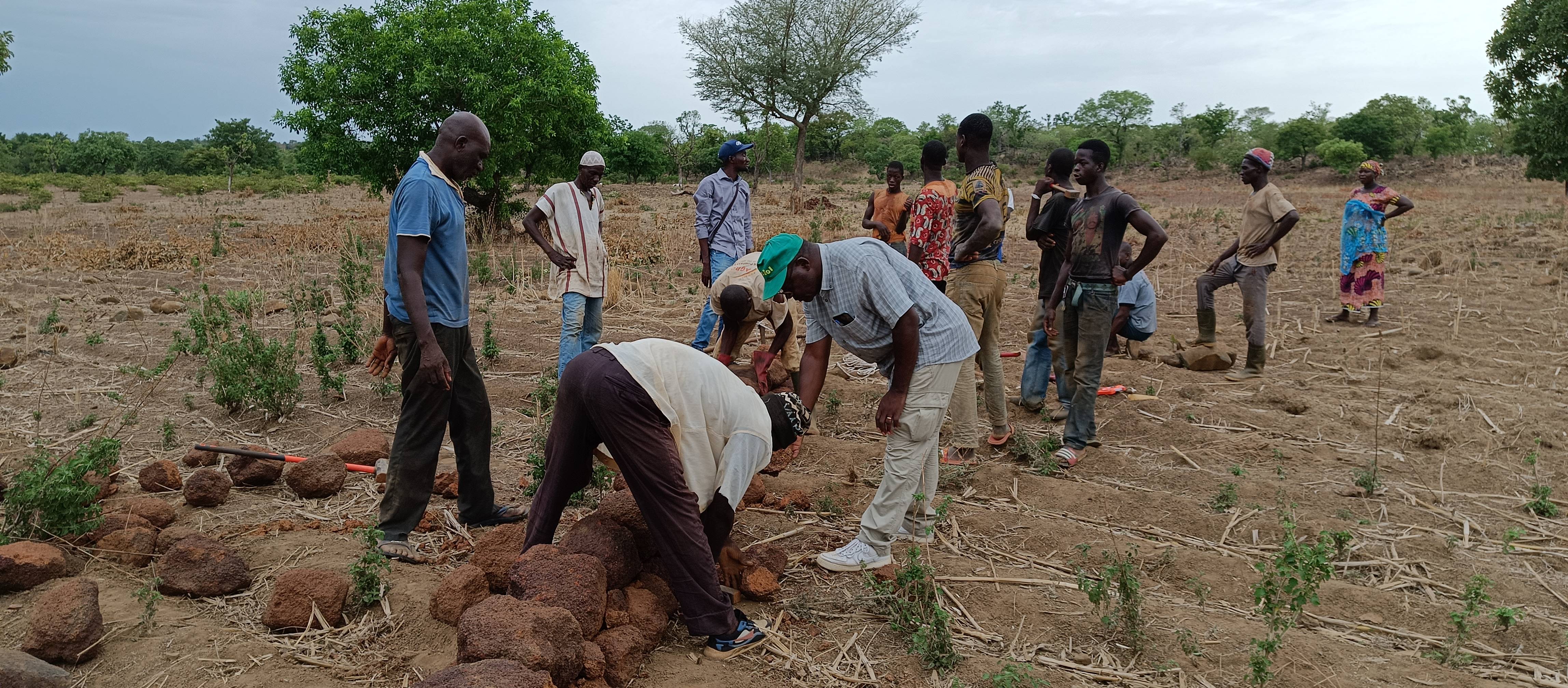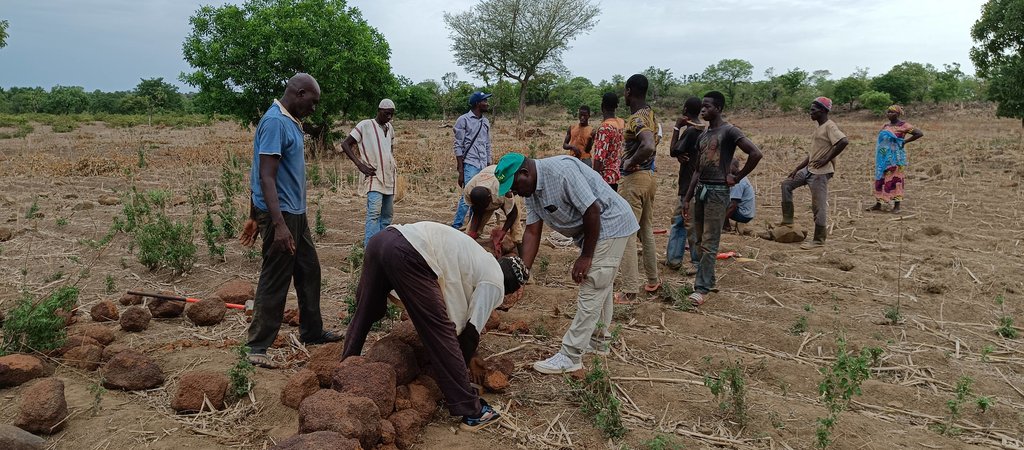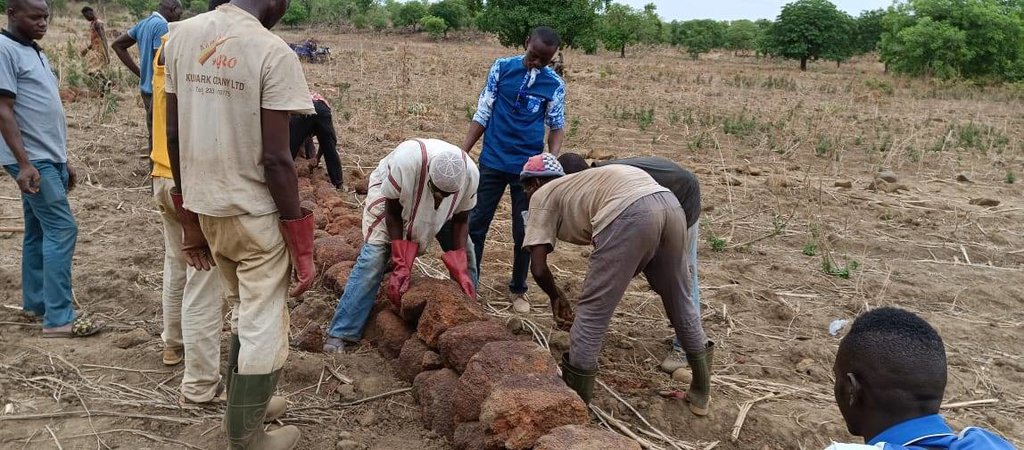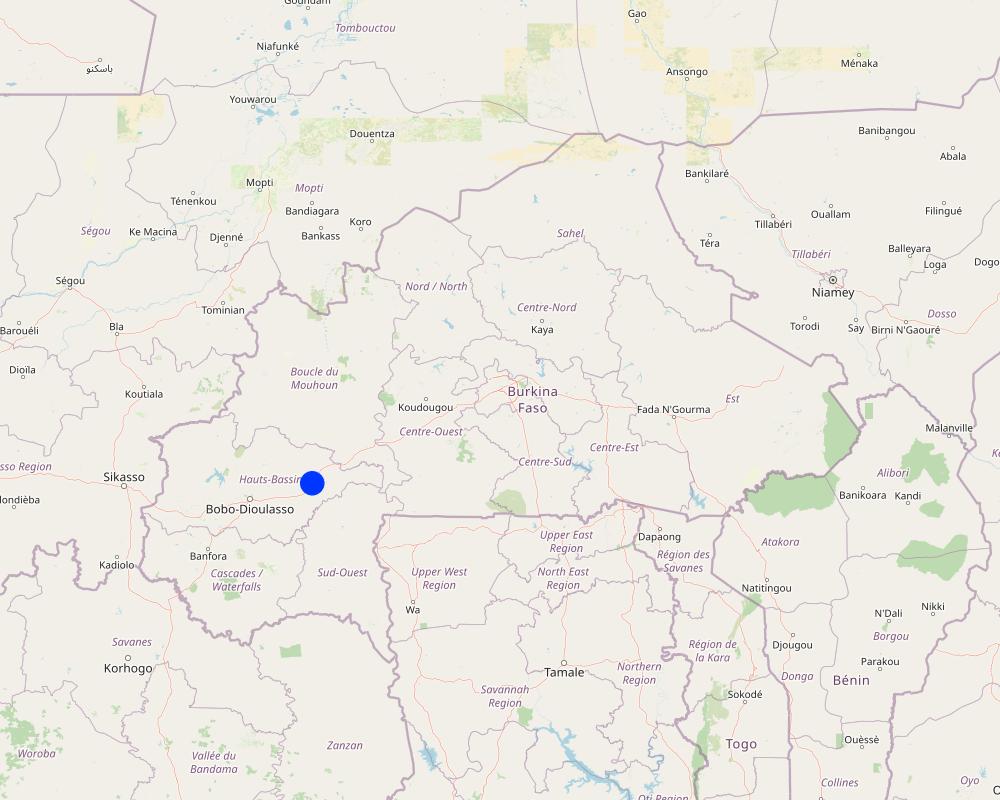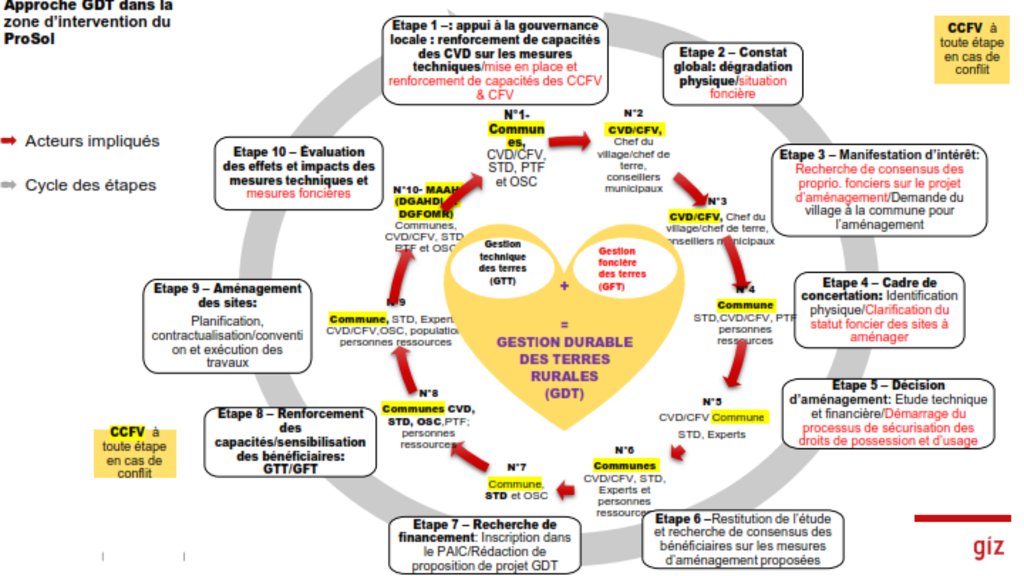SLM implementation through Village Development Councils [Burkina Faso]
- Creation:
- Update:
- Compiler: Moussa ABOU
- Editors: Siagbé Golli, Brice Sosthène BAYALA, Joachain PALE, Tabitha Nekesa, Ahmadou Gaye
- Reviewers: Sally Bunning, Rima Mekdaschi Studer, William Critchley
approaches_6733 - Burkina Faso
View sections
Expand all Collapse all1. General information
1.2 Contact details of resource persons and institutions involved in the assessment and documentation of the Approach
Key resource person(s)
land user:
PEHAN Lassina
+226 70 68 72 23
Burkina Faso
Name of project which facilitated the documentation/ evaluation of the Approach (if relevant)
Soil protection and rehabilitation for food security (ProSo(i)l)1.3 Conditions regarding the use of data documented through WOCAT
When were the data compiled (in the field)?
01/17/2023
The compiler and key resource person(s) accept the conditions regarding the use of data documented through WOCAT:
Yes
2. Description of the SLM Approach
2.1 Short description of the Approach
Sustainable Land Management (SLM) through Village Development Councils (CVDs) is an approach that empowers stakeholders to implement the SLM technologies promoted by ProSoil. This approach combines land tenure aspects with those of Sustainable Land Management.
2.2 Detailed description of the Approach
Detailed description of the Approach:
Implementing Sustainable Land Management (SLM) practices and addressing land-related issues through Village Development Councils (CDVs) is a participatory approach that empowers local stakeholders by emphasizing the importance of land tenure for the success and sustainability of SLM actions.
This approach aims to proactively anticipate land conflicts by clarifying land-related aspects before initiating any development. Its aim is to secure the consensus and agreement of beneficiaries regarding the adoption of SLM technologies promoted by ProSoil.
Implemented through a participatory and inclusive approach, various methods have been utilized, including capacity-building for farmers, mapping, consultation, information dissemination, and awareness-raising. The key stages of this approach are as follows:
1. Support for local governance processes;
2. Comprehensive assessment of the physical degradation/land tenure situation;
3. Expression of interest;
4. Consultation framework;
5. Development decision;
6. Feedback on the study and consensus-building among beneficiaries;
7. Fundraising;
8. Capacity-building/awareness-raising among beneficiaries;
9. Site development;
10. Assessment of the effects and impacts of the technical and land-related measures.
The main stakeholders involved in this strategy include municipalities (communes), CDVs, deconcentrated technical services (STDs), and local land authorities such as the land services, village land commissions, and village land conciliation commissions. ProSoil facilitated the establishment of SFRs, CFVs, and CCFVs in areas where they were previously non-existent. Once established, these entities, supported by communes, ProSoil, and civil society organizations, underwent training in various topics, including:
•the causes of soil degradation, anti-erosion measures, integrated soil fertility management;
•Act 034-2009/AN on rural land tenure and local conciliation mechanisms.
The key responsibilities of these stakeholders include raising awareness among land users about the multi-actor SLM approach, strengthening connections among SLM stakeholders, clarifying roles and responsibilities, jointly organizing SLM measures, integrating SLM measures into communal planning, and aligning land tenure with the "Land First" SLM approach. Additionally, these stakeholders play a role in providing a platform for exchange between local and national SLM stakeholders, building the capacity of stakeholders for collaborative SLM projects at the communal level, and capitalizing on a long-term SLM development approach.
Village Development Councils (CVDs) actively support the establishment of CFV/CCFVs, conduct inventories of landowning families, and are responsible for training, planning, executing development actions, and managing land issues. These responsibilities align with the provisions of Decree no. 2007-032/PRES/PM/MATD of January 22, 2007, on the organization, composition, and operation of village development councils. CVDs are accountable for the day-to-day management of village activities, including examining and providing written, reasoned opinions on development projects and programs, addressing issues affecting village development, and issuing detailed recommendations in areas such as preserving social peace, mobilizing the population around socio-economic initiatives, and protecting the environment.
Farmers express satisfaction with the participatory and inclusive nature of the process for implementing this approach. The approach fostered the involvement of all village stakeholders, leading to consensus and agreement on the implementation of SLM measures.
2.3 Photos of the Approach
2.5 Country/ region/ locations where the Approach has been applied
Country:
Burkina Faso
Region/ State/ Province:
Hauts-Bassins Region, Tuy Province
Further specification of location:
Dankari (Commune of Koumbia)
Map
×2.6 Dates of initiation and termination of the Approach
Indicate year of initiation:
2018
2.7 Type of Approach
- project/ programme based
2.8 Main aims/ objectives of the Approach
This approach is designed primarily to anticipate/ pre-empt land conflicts by clarifying land tenure issues prior to any development.
2.9 Conditions enabling or hindering implementation of the Technology/ Technologies applied under the Approach
social/ cultural/ religious norms and values
- enabling
Customary leaders are the custodians of customs and traditions. They also help maintain social peace and quiet by contributing to the prevention and management of land-related conflicts.
availability/ access to financial resources and services
- enabling
The availability of, and access to, financial resources and services has helped build farmers' capacities with regard to "Act No. 034-2009/AN on rural land tenure and its implementing regulations" and to "the causes of soil degradation, anti-erosion measures and integrated soil fertility management".
institutional setting
- enabling
The Village Land Commission (CFV), the Village Land Conciliation Commission (CCFV) and the Rural Land Service (SFR) play important roles in preventing and resolving rural land-related disputes.
collaboration/ coordination of actors
- enabling
Collaboration and coordination between stakeholders bolster the synergistic implementation of the approach.
legal framework (land tenure, land and water use rights)
- enabling
Act 034-2009/AN of June 16, 2009 on rural land tenure and its implementing decrees promote the implementation of the approach.
policies
- enabling
In addition, the implementation of the National Soil Restoration, Conservation and Reclamation Strategy (SNRCRS) in Burkina Faso 2020 - 2024 should reduce/reverse the trend of soil degradation, thereby sustainably increasing agricultural production.
land governance (decision-making, implementation and enforcement)
- enabling
Current local land management bodies (Village Land Commission, Village Land Conciliation Commission and Land Service) are involved in implementing this approach.
knowledge about SLM, access to technical support
- enabling
Providing training to farmers on "Act No. 034-2009/AN on rural land tenure and its implementing regulations" and educating them about "the causes of soil degradation, anti-erosion measures, and integrated soil fertility management" has heightened their awareness of Sustainable Land Management (SLM). Additionally, supporting bodies such as the CVD/CFV in obtaining user-friendly maps and offering training on map interpretation plays a role in fostering the implementation of this approach.
markets (to purchase inputs, sell products) and prices
- enabling
The proximity of the city of Bobo-Dioulasso (the economic capital) provides an opportunity to purchase agricultural inputs and sell produce at better prices.
workload, availability of manpower
- enabling
The population of Koumbia commune, much like that of Burkina Faso as a whole, is primarily composed of young individuals. This youthful demographic serves as a valuable labour pool for engaging in agroforestry activities.
3. Participation and roles of stakeholders involved
3.1 Stakeholders involved in the Approach and their roles
- local land users/ local communities
Participation in the implementation process of the approach and consensus and agreement building among SLM stakeholders
- SLM specialists/ agricultural advisers
Their role is to coordinate the process of developing the approach using a participatory and inclusive approach. The Head of the Rural Land Service (SFR), who works in collaboration with the Village Development Council (CVD), the ProSoil land specialist and the Directorate-General for Land Tenure and Rural Organisation (DGFOMR), supported the process.
- NGO
Its role consisted of providing technical and financial support to those involved in implementing the approach.
- private sector
The private sector does not possess land ownership but plays a role as a service provider in the process. Primarily consisting of experts, their responsibility is to provide detailed insights in the mission report, offering summarized proposals for development techniques and assessing the land situation on the identified site. The involvement of the private sector occurs when consensus among stakeholders indicates the necessity to develop the identified site.
If several stakeholders were involved, indicate lead agency:
ProSol
3.2 Involvement of local land users/ local communities in the different phases of the Approach
| Involvement of local land users/ local communities | Specify who was involved and describe activities | |
|---|---|---|
| initiation/ motivation | interactive | Local land users participated in nearly every stage of establishing the approach, leading to a consensus and agreement regarding the implementation of the proposed improvements. |
| planning | interactive | With the exception of fundraising, land users were involved at every stage of the implementation of the approach. |
| implementation | interactive | Local land users are collaboratively engaged in the establishment of the approach, especially since they participate in the working groups set up to implement it. |
| monitoring/ evaluation | interactive | Local land users form an integral part of the process of assessing the effects and impacts of technical and land-related measures. |
3.3 Flow chart (if available)
Description:
Process for implementing the approach in the ProSol area of intervention
Author:
ProSoil/GIZ
3.4 Decision-making on the selection of SLM Technology/ Technologies
Specify who decided on the selection of the Technology/ Technologies to be implemented:
- all relevant actors, as part of a participatory approach
Explain:
The approach was implemented through a participatory and inclusive process. This led to an agreement to implement SLM.
Specify on what basis decisions were made:
- evaluation of well-documented SLM knowledge (evidence-based decision-making)
4. Technical support, capacity building, and knowledge management
4.1 Capacity building/ training
Was training provided to land users/ other stakeholders?
Yes
Specify who was trained:
- land users
- field staff/ advisers
Form of training:
- public meetings
- courses
Subjects covered:
• Causes of soil degradation, anti-erosion measures and integrated soil fertility management;
• Act 034-2009/AN on rural land tenure and local conciliation mechanisms;
• Conflict management;
• The procedure for submitting a request to the Town Hall.
Comments:
The aim of this training and mass awareness-raising was to prepare the local population for the smooth implementation, peaceful operation and maintenance of the facilities.
4.2 Advisory service
Do land users have access to an advisory service?
Yes
Specify whether advisory service is provided:
- on land users' fields
Describe/ comments:
The Decentralised Technical Services (STD) provide ongoing technical assistance to land users as they carry out their activities.
4.3 Institution strengthening (organizational development)
Have institutions been established or strengthened through the Approach?
- yes, a little
Specify the level(s) at which institutions have been strengthened or established:
- local
Describe institution, roles and responsibilities, members, etc.
The Rural Land Service is entrusted with the management and safeguarding of the commune's land holdings, which encompass local shared natural resources and private individuals' land within the commune. This department comprises the following offices:
•the Land Registry and Information Office; and
•the Topographic Office.
The Village Land Commission plays a crucial role in supporting the effective implementation of the Rural Land Service's missions by contributing to the security and management of the commune's land holdings while assisting in securing land tenure for all rural stakeholders. Specifically, the Commission is responsible for raising awareness about land issues, identifying local natural resource areas for common use, participating in the recording of local land rights and, in general, working to prevent rural land conflicts (Article 82). The Village Land Commission has a maximum of nine (09) members, appointed by the Village Assembly (Article 10).
The CCFV is competent to hear disputes relating to access to and/or use of rural land and natural resources, with the exception of those in areas governed by specific regimes, notably the Mining Code. The CCFV is composed of :
•one (01) chairman, who is the representative of the customary and traditional authorities responsible for land issues;
•full members and alternate members;
•one (01) full secretary and one deputy secretary (who is able to read and write in French).
Specify type of support:
- capacity building/ training
Give further details:
Capacity-building/training focused on the following topics:
•The causes of soil degradation, anti-erosion measures and integrated soil fertility management;
•Act 034-2009/AN on rural land tenure and local conciliation mechanisms;
•Conflict management; and
•The Procedure for submitting a request to the Town Hall.
4.4 Monitoring and evaluation
Is monitoring and evaluation part of the Approach?
Yes
Comments:
The tenth step in the approach involves evaluating the effects and impacts of technical and land-related measures. It consists of regularly assessing the impact or effects of developments on reducing land degradation, increasing production, and preserving the environment. This evaluation will be carried out as part of the assessment of the baseline situation of degraded land, which may take place in 2024. It is the responsibility of the Ministry of Agriculture through the General Directorate of Hydraulic Facilities and Irrigation Development (DGAHDI), with the collaboration of the communes concerned and the support of civil society organizations (CSOs), technical and financial partners (TFPs), etc.
If yes, is this documentation intended to be used for monitoring and evaluation?
Yes
Comments:
The purpose of this document is to facilitate monitoring and evaluation processes. Therefore, it will help assess trends in land degradation and draw up recommendations.
4.5 Research
Was research part of the Approach?
No
5. Financing and external material support
5.1 Annual budget for the SLM component of the Approach
If precise annual budget is not known, indicate range:
- 10,000-100,000
Comments (e.g. main sources of funding/ major donors):
Prosol is the main source of funding.
5.2 Financial/ material support provided to land users
Did land users receive financial/ material support for implementing the Technology/ Technologies?
Yes
If yes, specify type(s) of support, conditions, and provider(s):
As part of the implementation of the approach, land users are provided with basic tools such as pickaxes, hammers, shovels, wheelbarrows, and building materials like rubble and seeds. These resources are allocated to the working groups established by ProSoil, specifically for implementing the technologies it promotes. Apart from the didactic tools provided during training sessions, farmers do not receive any other equipment. ProSoil maintains a consistent land strategy across its entire intervention zone.
5.3 Subsidies for specific inputs (including labour)
- equipment
| Specify which inputs were subsidised | To which extent | Specify subsidies |
|---|---|---|
| tools | fully financed | Subsidies are available for pickaxes, wheelbarrows, gloves, water levels, carts, forks, watering cans, shovels, hammers, and so on. |
- construction
| Specify which inputs were subsidised | To which extent | Specify subsidies |
|---|---|---|
| stone | fully financed | These are stones used in the construction of physical water and soil conservation structures. |
| Seeds and plants | fully financed | These inputs are used in the revegetation of soil and water conservation and restoration structures, either by direct sowing or by transplanting. |
If labour by land users was a substantial input, was it:
- paid in cash
5.4 Credit
Was credit provided under the Approach for SLM activities?
No
5.5 Other incentives or instruments
Were other incentives or instruments used to promote implementation of SLM Technologies?
No
6. Impact analysis and concluding statements
6.1 Impacts of the Approach
Did the Approach empower local land users, improve stakeholder participation?
- No
- Yes, little
- Yes, moderately
- Yes, greatly
The information and awareness-raising sessions conducted within the framework of this approach have enhanced stakeholder participation and commitment to the process.
Did the Approach enable evidence-based decision-making?
- No
- Yes, little
- Yes, moderately
- Yes, greatly
The implementation of this approach started with farmers observing the deterioration of their soil capital, leading to expressions of interest in development projects.
Did the Approach help land users to implement and maintain SLM Technologies?
- No
- Yes, little
- Yes, moderately
- Yes, greatly
Prior to its implementation, mass awareness-raising sessions on Sustainable Land Management (SLM) and land tenure management were conducted for beneficiary communities. In addition, the approach is implemented through Working Groups (WGs), which are essentially made up of land users who have been trained in setting up and maintaining the technologies. In the field, land users are responsible for implementing and maintaining SLM technologies. In view of these observations, it can be said that the Approach has helped land users to implement and maintain SLM technologies.
Did the Approach improve coordination and cost-effective implementation of SLM?
- No
- Yes, little
- Yes, moderately
- Yes, greatly
The decision to implement SLM measures promoted by ProSoil, is preceded by technical and financial studies involving various stakeholders such as CVDs, experts, STDs, land users, and ProSoil. This collaborative, consensus-driven, multi-stakeholder approach is underpinned by a cost-benefit and economic analysis of WSC/SDR measures. This study made it possible to carry out an economic analysis of the impact of the works in order to demonstrate that investing in WSC/SDR measures is not only economically profitable but also politically advantageous and socially essential. We can therefore conclude that the Approach has improved the coordination and implementation of SLM in a cost-effective manner.
Did the Approach mobilize/ improve access to financial resources for SLM implementation?
- No
- Yes, little
- Yes, moderately
- Yes, greatly
Fundraising is one of the stages of the Approach. Once the technical report and budget have been validated, the commune begins the process of seeking funding. This involves establishing partnerships with projects, programs, industries (such as mining companies), and TFPs operating both at the municipal and national levels. ProSoil has implemented a three-fold support initiative for communes, aimed at facilitating their fundraising efforts: •Identifying existing available national and international funds dedicated to SLM; •Providing training to communes and private operators in crafting project proposals aligned with the frameworks of these identified funds, and developing SLM projects for submission to various funding sources. •Monitoring the process from proposal submission to the successful acquisition of SLM funding. To the extent SLM measures have been executed in the ProSoil intervention zone, it can be inferred that the Approach has facilitated/enhanced access to financial resources for the implementation of SLM.
Did the Approach improve knowledge and capacities of land users to implement SLM?
- No
- Yes, little
- Yes, moderately
- Yes, greatly
One of the cornerstones of the Approach lies in capacity-building initiatives for farmers. To this end, farmers have been trained in a number of areas, including Technical Land Management (TLM), land tenure management, and the implementation and maintenance of SLM technologies promoted by ProSoil. These various capacity-building actions empower land users organized in working groups to implement and sustain the SLM measures promoted by ProSoil. Consequently, it can be concluded that the Approach has enhanced the knowledge and capabilities of land users in the implementation of SLM.
Did the Approach improve knowledge and capacities of other stakeholders?
- No
- Yes, little
- Yes, moderately
- Yes, greatly
The implementation of SLM by the CVDs follows a consensual, multi-stakeholder approach. All stakeholders in this process benefit from capacity-building initiatives, including the upgrading of public and private service providers and the reinforcement of a system of relay farmer trainers. This leads to the conclusion that the approach has improved the knowledge and capacities of the other stakeholders involved.
Did the Approach mitigate conflicts?
- No
- Yes, little
- Yes, moderately
- Yes, greatly
The aim of this approach is to anticipate and mitigate land conflicts by clarifying land tenure aspects before any development takes place. While statistics on conflict reduction following the approach's implementation are unavailable, the implementation developments at the micro-basin level confirms this. This holds even more significance, as development becomes unattainable in the absence of consensus.
Did the Approach improve gender equality and empower women and girls?
- No
- Yes, little
- Yes, moderately
- Yes, greatly
The approach is implemented at the micro-catchment level through a participatory and inclusive process, ensuring the involvement of all segments of society without discrimination. Consequently, it can be inferred that the approach has enhanced gender equality and empowered women and girls.
Did the Approach improve issues of land tenure/ user rights that hindered implementation of SLM Technologies?
- No
- Yes, little
- Yes, moderately
- Yes, greatly
The approach is based on a participatory and inclusive methodology aiming to achieve agreement and consensus. Given the successful implementation of several SLM measures in the ProSoil intervention zone, it can be affirmed that the approach has addressed the land tenure and use rights issues hindering the implementation of the technologies.
Did the Approach lead to improved food security/ improved nutrition?
- No
- Yes, little
- Yes, moderately
- Yes, greatly
This approach is a prerequisite for implementing SLM measures in the ProSoil intervention zone. Insights gathered from discussions with land users during the documentation of SLM technologies indicate a noticeable rise in agricultural yields subsequent to the implementation of SLM. Based on this information, we conclude that the Approach has led to improved food security and/or nutrition.
Did the Approach improve access to markets?
- No
- Yes, little
- Yes, moderately
- Yes, greatly
The objective of the Approach is to secure the consensus and agreement of beneficiaries for the implementation of technologies promoted by ProSoil. It is therefore not market-oriented, which leads us to assert that it has not improved access to markets.
Did the Approach lead to improved access to water and sanitation?
- No
- Yes, little
- Yes, moderately
- Yes, greatly
Land users have not established a connection between the Approach and enhanced access to water and sanitation.
Did the Approach improve the capacity of the land users to adapt to climate changes/ extremes and mitigate climate related disasters?
- No
- Yes, little
- Yes, moderately
- Yes, greatly
The Approach is designed to implement all the SWH/SRH technologies promoted by ProSoil. The implementation of these technologies is preceded by capacity building for land users. Additionally, during the documentation of certain SLM technologies, land users affirmed that the approach has enhanced their capacities to adapt to climate change, extremes, and disasters, and mitigate climate-related disasters.
Did the Approach lead to employment, income opportunities?
- No
- Yes, little
- Yes, moderately
- Yes, greatly
The various technologies are implemented by working groups made up of land users. These groups assert that the application of these technologies has led to increased agricultural yields and, consequently, created opportunities for improved income.
6.2 Main motivation of land users to implement SLM
- conflict mitigation
Land users highlighted the existence of conflicts among farmers, with a particular emphasis on tensions between indigenous and migrant farmers. These conflicts stem from various causes, including the appropriation of migrant land by indigenous farmers and disputes arising from the non-adherence to "sale agreements." In addressing this situation, ProSoil is promoting the development of local land charters and the issuance of Rural Land Ownership Certificates (APFRs), which serve as certificates providing security for rural land possession.
6.3 Sustainability of Approach activities
Can the land users sustain what has been implemented through the Approach (without external support)?
- uncertain
If no or uncertain, specify and comment:
The expenses associated with implementing SLM technologies endorsed by ProSoil are substantial. Consequently, it will be difficult for land users to sustain the implemented measures through the Approach without external support.
6.4 Strengths/ advantages of the Approach
| Strengths/ advantages/ opportunities in the land user’s view |
|---|
| Information/awareness-raising/training |
| Collaboration |
| Consensus / Agreement |
| Strengths/ advantages/ opportunities in the compiler’s or other key resource person’s view |
|---|
| Assessment of the physical degradation of the land. |
| Assessment of the land tenure situation on the site |
| Formulation of a request regarding development requirements. |
6.5 Weaknesses/ disadvantages of the Approach and ways of overcoming them
| Weaknesses/ disadvantages/ risks in the land user’s view | How can they be overcome? |
|---|---|
| Risk of conflict over developed lands | Emphasize information/awareness-raising for beneficiary communities and consultation under the responsibility of SFRs and CVDs. Subsequently, local land charters governing the management of the sites concerned will need to be drawn up and secured through the issuance of Rural Land Ownership Certificates (APFR). |
| Weaknesses/ disadvantages/ risks in the compiler’s or other key resource person’s view | How can they be overcome? |
|---|---|
| A lack of interest on the part of technical and financial partners (TFPs) in financing SLM and land tenure. | Emphasize research and diversification of TFPs. |
7. References and links
7.1 Methods/ sources of information
- field visits, field surveys
1
- interviews with land users
3
- interviews with SLM specialists/ experts
1
- compilation from reports and other existing documentation
8
7.2 References to available publications
Title, author, year, ISBN:
Stratégie Nationale de Restauration, Conservation et Récupération des Sols (SNRCRS) au Burkina Faso 2020 – 2024, Ministère de l’Agriculture et des Aménagements Hydro-Agricoles, 2019/National Soil Restoration, Conservation and Reclamation Strategy (SNRCRS) in Burkina Faso 2020 - 2024, Ministry of Agriculture and Hydro-Agricultural Development, 2019
Available from where? Costs?
Available at ProSol
Title, author, year, ISBN:
Act 034-2009/AN on land tenure in Burkina Faso, Burkina Faso, 2009
Available from where? Costs?
Available on the Internet
Title, author, year, ISBN:
Decree No. 2007-032/PRES/PM/MATD of January 22, 2007 on the organization, formation and operation of Village Development Councils (CVD), Burkina Faso, 2007
Available from where? Costs?
Available on the Internet
Title, author, year, ISBN:
Catalogue de fiches techniques des mesures d’amélioration de la fertilité des sols, Projet « Réhabilitation et protection des sols dégradés et renforcement des instances foncières locales dans les zones rurales du Burkina Faso » (ProSol), 2020/Technical data sheet catalogue on soil fertility improvement measures, "Rehabilitation and protection of degraded soils and strengthening of local land tenure authorities in rural areas of Burkina Faso" (ProSol), 2020
Available from where? Costs?
Available at ProSol Burkina Faso
Title, author, year, ISBN:
Réalisation d’un diagnostic de l’état des ressources naturelles et de la gestion foncière dans les régions du Sud-Ouest et des Hauts-Bassins au Burkina Faso, Projet « Réhabilitation et protection des sols dégradés et renforcement des instances foncières locales dans les zones rurales du Burkina Faso » (ProSol), 2015/Conducting a diagnosis of the state of natural resources and land tenure management in the South-West and Hauts-Bassins regions of Burkina Faso, "Rehabilitation and protection of degraded soils and strengthening of local land tenure bodies in rural areas of Burkina Faso" (ProSol), 2015
Available from where? Costs?
Available at ProSol Burkina Faso
Title, author, year, ISBN:
Module de Gestion Durable des Terres (GDT) sensible au Genre, ProSol, 2021/Gender-sensitive Sustainable Land Management (SLM) Module, ProSol, 2021
Available from where? Costs?
Available at ProSol Burkina Faso
Title, author, year, ISBN:
Decree No. 2010-404__/PRES/PM/MAHRH/MRA/ MECV/MEF/MATD on the attributions, formation, organization and operation of local land management bodies, Burkina Faso, 2010
Available from where? Costs?
Available on the Internet
Title, author, year, ISBN:
National Soil Restoration, Conservation and Recovery Strategy in Burkina Faso (2020 - 2024), Ministry of Agriculture and Hydro-Agricultural Development of Burkina Faso, 2019
Available from where? Costs?
Available on the Internet
7.3 Links to relevant information which is available online
Title/ description:
Technical Guide on the Integration of the Voluntary Guidelines on the Responsible Governance of Tenure of Land, Fisheries and Forests in the Context of National Food Security into the Implementation of the United Nations Convention to Combat Desertification and Land Degradation NeutralityFAO, Rome and UNCCD
URL:
https://www.unccd.int/sites/default/files/2023-04/VGGT%20guide%20FRE.pdf
Links and modules
Expand all Collapse allLinks
No links
Modules
No modules


